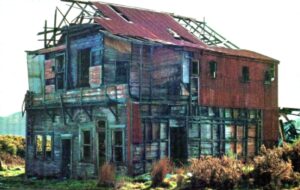1866: Charleston
March 1, 2022
By AHNZ
 Rome wasn’t build in a day but New Zealand’s Gold Rush towns were But Rome was made to last a long time before fading away wheres places like Charleston (est. 1866) were quick to rise and then burn out. A recently shared article from 1956 points out that the town had 12,000 people and 80 hotels/pubs to serve them. Evidently it was not about alcohol distribution alone.
Rome wasn’t build in a day but New Zealand’s Gold Rush towns were But Rome was made to last a long time before fading away wheres places like Charleston (est. 1866) were quick to rise and then burn out. A recently shared article from 1956 points out that the town had 12,000 people and 80 hotels/pubs to serve them. Evidently it was not about alcohol distribution alone.
These many hotels and pubs served as community hubs, a networking and administrative center. Houses and miners’ tents could not serve that function. Historian John Rosanowski has said that the names of the names of these establishments were not a gimmick as today but rather indicated who was welcome inside. Eg. Europeans. Eg. All Nations
At the end of the century this sort of community structure became under attack. The same thing had happened back in Britain in the 1830s and would do so again in New Zealand’s 1910s. This indicates a 40-year cycle but after the next one, in the 1950s (Licensing Trusts) there wasn’t much organic community work based in pubs left to assimilate. The work communities had organised from their local hotel/pub was taken over instead by The State.
The drug of alcohol was used as a proxy to bring down the old establishment which was the true target of what they called ‘Prohibition’. The bourgeois class sought to take hegemony over New Zealand and eliminated the nervous system of the working class community in the guise of denigrating their drinking habits.
“The creation of public hysteria about specific types of drugs is largely political: it is a tool by which a dominant culture denigrates a minority one. Conclusion- Drugs are politically and ideologically driven not fact-driven.” – Lecture notes from Soc 218, Crime and Justice, Greg Newbold (2008)
“At one time the town had 80 public houses, together with dance halls and the usual attributes of the old-time mushroom mining towns.” – The New Zealand Guide (1957)
“..Charleston was a hub of men’s hopes and fortunes. It is now less than a ghost town. Grass covers the haunts of the gold-seekers and fossickers; the sites of the dance halls, casinos and luxury shops are bare and foresaken. The story is told that in its rip-roaring hey-day, every second building was a public house; only one still remains as a solitary roadhouse.” – Vol. 1 Women of Westland (1960)
This is a generalised way of understanding what Charleston was beyond the particulars. The European Hotel building lingered on the longest. It featured in the logo of the 1966 centenary as shown by surviving commemorative cups and plates. The building was pulled down around 1970 which is unfortunate because in the very next year New Zealand gave birth to a new heritage zeal that might have saved it. On the other hand, the sacrifice of buildings like this are part of what primed the pump for that renaissance.
—
Image ref. European Hotel, Charleston, ca. early 1960s, West Coast History
Image ref. European Hotel, Charleston, c.1950s, West Coast History, Facebook
 Like Comment Share
Like Comment Share






One thought on "1866: Charleston"